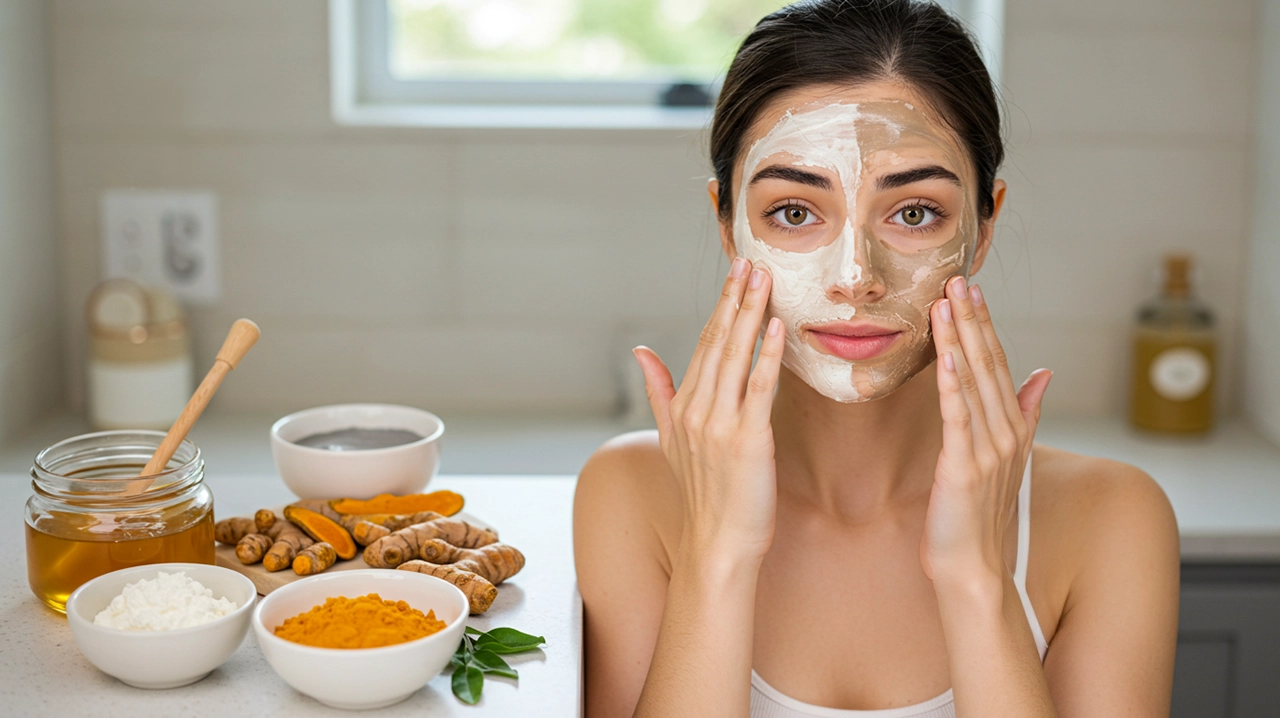

Easy homemade face mask for teenage acne
Are you tired of battling stubborn teenage acne? 😫 Look no further! Your search for clear, radiant skin ends here. Discover the power of easy homemade face masks that can transform your complexion and boost your confidence.
Imagine waking up every morning to smooth, blemish-free skin. 🌟 No more hiding behind layers of makeup or feeling self-conscious about your appearance. With our simple, natural remedies, you’ll learn how to create effective face masks using ingredients from your own kitchen. Say goodbye to expensive store-bought products and hello to affordable, personalized skincare solutions!
In this blog post, we’ll guide you through the world of teenage acne, revealing the essential ingredients that combat those pesky breakouts. You’ll discover quick and easy face mask recipes, learn how to apply them for maximum effectiveness, and explore complementary skincare habits to maintain your newfound glow. Get ready to unlock the secrets to clear, healthy skin – your journey to acne-free confidence starts now!

Common causes of teenage acne
Teenage acne is a common skin condition that affects millions of adolescents worldwide. Understanding its causes is crucial for effective treatment. Here are the primary factors contributing to teenage acne:
Hormonal changes
Excess oil production
Clogged pores
Bacteria buildup
Genetics
| Factor | Description |
|---|---|
| Hormones | Increased androgen levels stimulate oil glands |
| Oil Production | Excess sebum can lead to clogged pores |
| Clogged Pores | Dead skin cells and oil trap bacteria |
| Bacteria | P. acnes multiply in clogged pores, causing inflammation |
| Genetics | Family history can increase acne susceptibility |
Why homemade face masks can help
Homemade face masks offer a natural and cost-effective solution for managing teenage acne. These DIY treatments can:
Absorb excess oil
Exfoliate dead skin cells
Reduce inflammation
Provide essential nutrients to the skin
By using natural ingredients, you can avoid harsh chemicals that may irritate sensitive teenage skin.
Benefits of natural ingredients
Natural ingredients in homemade face masks offer numerous advantages for acne-prone skin:
Gentle on skin: Less likely to cause irritation or dryness
Nutrient-rich: Provide vitamins and minerals that nourish the skin
Antioxidant properties: Help fight free radicals and reduce inflammation
Antimicrobial effects: Some ingredients naturally combat acne-causing bacteria
Now that you understand the causes of teenage acne and the benefits of homemade face masks, let’s explore the essential ingredients you’ll need to create effective acne-fighting treatments.
Honey: Nature’s antibacterial agent
Honey is a powerhouse ingredient for your homemade acne face mask. Its natural antibacterial properties make it an excellent choice for fighting the bacteria that cause acne. You’ll love how honey helps to cleanse your skin while keeping it moisturized.
Tea tree oil: Powerful antiseptic properties
When it comes to battling teenage acne, tea tree oil is your secret weapon. This essential oil packs a punch with its strong antiseptic qualities. You’ll find it’s particularly effective in reducing inflammation and killing acne-causing bacteria.
Aloe vera: Soothing and healing
Your skin will thank you for including aloe vera in your face mask. This natural ingredient is renowned for its soothing and healing properties. You’ll notice how it calms irritated skin and helps reduce redness associated with acne.
Lemon juice: Natural astringent
Lemon juice is a fantastic addition to your acne-fighting arsenal. As a natural astringent, it helps tighten your pores and control excess oil production. You’ll appreciate how it brightens your complexion and fades acne scars over time.
Here’s a quick comparison of these ingredients:
| Ingredient | Main Benefit | Best for |
|---|---|---|
| Honey | Antibacterial | All skin types |
| Tea tree oil | Antiseptic | Oily, acne-prone skin |
| Aloe vera | Soothing | Sensitive, irritated skin |
| Lemon juice | Astringent | Oily skin, acne scars |
When creating your homemade face mask, consider combining these ingredients for maximum effect:
Mix honey and aloe vera for a soothing, antibacterial mask
Blend tea tree oil with honey for a powerful acne-fighting treatment
Combine lemon juice and aloe vera to brighten and calm your skin
Now that you’re familiar with these essential ingredients, let’s explore some quick and easy face mask recipes you can whip up at home.

Honey and Cinnamon Mask
You’ll love this simple yet effective mask! Mix 2 tablespoons of raw honey with 1 teaspoon of ground cinnamon. Apply to your face, leave for 15 minutes, then rinse with warm water.
Green Tea and Lemon Mask
Brew a strong cup of green tea and let it cool. Mix 2 tablespoons of the tea with 1 teaspoon of fresh lemon juice. Apply the mixture to your face, wait for 10 minutes, and rinse off.
Oatmeal and Yogurt Mask
Combine 2 tablespoons of ground oatmeal with 2 tablespoons of plain yogurt. Spread evenly on your face, relax for 15-20 minutes, then wash off with lukewarm water.
Aloe Vera and Tea Tree Oil Mask
Mix 2 tablespoons of aloe vera gel with 2-3 drops of tea tree oil. Apply a thin layer to your face, leave for 15 minutes, and rinse thoroughly.
Turmeric and Milk Mask
Blend 1 teaspoon of turmeric powder with 2 tablespoons of milk to form a paste. Apply to your face, wait for 10-15 minutes, then rinse off gently.
| Mask Type | Main Ingredients | Benefits |
|---|---|---|
| Honey & Cinnamon | Raw honey, Ground cinnamon | Antibacterial, Anti-inflammatory |
| Green Tea & Lemon | Green tea, Lemon juice | Antioxidant, Astringent |
| Oatmeal & Yogurt | Ground oatmeal, Plain yogurt | Exfoliating, Soothing |
| Aloe Vera & Tea Tree Oil | Aloe vera gel, Tea tree oil | Healing, Antiseptic |
| Turmeric & Milk | Turmeric powder, Milk | Anti-inflammatory, Brightening |
These easy homemade face masks use natural ingredients that you likely already have in your kitchen. Remember to:
Always do a patch test before applying any new ingredient to your face
Use these masks 1-2 times a week for best results
Follow up with a gentle moisturizer after rinsing off the mask
Now that you have these simple recipes, let’s move on to how you can apply these homemade face masks effectively for maximum benefits.

Preparing your skin
Before applying your homemade acne face mask, it’s crucial to prepare your skin properly. Start by washing your face with a gentle cleanser to remove any dirt, oil, or makeup. Pat your skin dry with a clean towel, avoiding harsh rubbing that can irritate acne-prone skin.
Proper application techniques
To get the most out of your homemade face mask, follow these application techniques:
Use clean hands or a brush to apply the mask
Apply an even layer across your face, avoiding the eye area
Gently massage the mask into your skin using circular motions
Pay extra attention to acne-prone areas
| Technique | Benefit |
|---|---|
| Even application | Ensures uniform treatment |
| Gentle massage | Improves blood circulation |
| Focusing on problem areas | Targets acne-prone zones |
Recommended duration
The ideal duration for your homemade acne face mask depends on the ingredients used. Generally, you should leave the mask on for:
Clay-based masks: 10-15 minutes
Honey-based masks: 15-20 minutes
Oatmeal masks: 10-15 minutes
Be careful not to leave the mask on for too long, as this can dry out your skin and potentially worsen acne.
Removal and aftercare
When it’s time to remove your mask, use lukewarm water and gentle circular motions to rinse it off thoroughly. Avoid using hot water, as it can irritate your skin. After removal, pat your face dry with a clean towel and apply a light, oil-free moisturizer to keep your skin hydrated.
Now that you know how to apply your homemade face mask effectively, let’s explore some complementary skincare habits that can help you maintain clear, healthy skin.
Gentle cleansing routine
A gentle cleansing routine is crucial for maintaining clear skin. You should wash your face twice daily using a mild, non-comedogenic cleanser. Avoid harsh scrubs or exfoliants that can irritate acne-prone skin. Instead, use lukewarm water and your fingertips to massage the cleanser in circular motions. Rinse thoroughly and pat dry with a clean towel.
Importance of moisturizing
Contrary to popular belief, moisturizing is essential even for oily, acne-prone skin. You need to choose a lightweight, oil-free moisturizer to keep your skin hydrated without clogging pores. Apply it while your skin is still damp to lock in moisture. This helps maintain your skin’s natural barrier and can actually reduce excess oil production.
Sun protection tips
Protecting your skin from the sun is crucial for preventing acne scarring and hyperpigmentation. You should apply a broad-spectrum sunscreen with at least SPF 30 daily, even on cloudy days. Look for non-comedogenic formulas specifically designed for acne-prone skin.
Dietary considerations for clear skin
What you eat can significantly impact your skin health. Consider incorporating these skin-friendly foods into your diet:
| Food Group | Benefits | Examples |
|---|---|---|
| Antioxidant-rich foods | Fight inflammation | Berries, leafy greens |
| Omega-3 fatty acids | Reduce inflammation | Salmon, walnuts |
| Low-glycemic foods | Regulate hormones | Whole grains, legumes |
| Zinc-rich foods | Support skin healing | Pumpkin seeds, lean meats |
Additionally, you should limit your intake of dairy and high-sugar foods, as they may contribute to acne flare-ups. Remember to stay hydrated by drinking plenty of water throughout the day to help flush out toxins and keep your skin clear.
As you embark on your journey to clearer skin, don’t forget that consistency is key. Incorporate these homemade face masks into your regular skincare routine, and be patient with the process. With time and dedication, you’ll likely see improvements in your skin’s appearance and health. Keep exploring different natural ingredients and recipes to find what works best for your unique skin type and acne concerns.

Skincare researcher and content creator dedicated to helping readers achieve healthy, glowing skin. With a deep understanding of skincare ingredients, routines, and industry trends, she combines scientific insights with practical tips to educate and empower her audience.
Your Ultimate Guide to Healthy, Glowing Skin – Expert Tips, Honest Reviews & Skincare Secrets!
Sign up our newsletter to get update tips, honest reviews & skincare secrets!